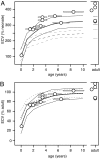Neanderthal brain size at birth provides insights into the evolution of human life history
- PMID: 18779579
- PMCID: PMC2533682
- DOI: 10.1073/pnas.0803917105
Neanderthal brain size at birth provides insights into the evolution of human life history
Abstract
From birth to adulthood, the human brain expands by a factor of 3.3, compared with 2.5 in chimpanzees [DeSilva J and Lesnik J (2006) Chimpanzee neonatal brain size: Implications for brain growth in Homo erectus. J Hum Evol 51: 207-212]. How the required extra amount of human brain growth is achieved and what its implications are for human life history and cognitive development are still a matter of debate. Likewise, because comparative fossil evidence is scarce, when and how the modern human pattern of brain growth arose during evolution is largely unknown. Virtual reconstructions of a Neanderthal neonate from Mezmaiskaya Cave (Russia) and of two Neanderthal infant skeletons from Dederiyeh Cave (Syria) now provide new comparative insights: Neanderthal brain size at birth was similar to that in recent Homo sapiens and most likely subject to similar obstetric constraints. Neanderthal brain growth rates during early infancy were higher, however. This pattern of growth resulted in larger adult brain sizes but not in earlier completion of brain growth. Because large brains growing at high rates require large, late-maturing, mothers [Leigh SR and Blomquist GE (2007) in Campbell CJ et al. Primates in perspective; pp 396-407], it is likely that Neanderthal life history was similarly slow, or even slower-paced, than in recent H. sapiens.
Conflict of interest statement
The authors declare no conflict of interest.
Figures




References
-
- Smith BH, Tompkins RL. Toward a life history of the Hominidae. Ann Rev Anthropol. 1995;24:257–279.
-
- Leigh SR. Brain growth, life history, and cognition in primate and human evolution. Am J Primatol. 2004;62:139–164. - PubMed
-
- Vinicius L. Human encephalization and developmental timing. J Hum Evol. 2005;49:762–776. - PubMed
-
- Leigh SR. Brain ontogeny and life history in Homo erectus. J Hum Evol. 2006;50:104–108. - PubMed
-
- Leigh SR, Blomquist GE. In: Primates in Perspective. Campbell CJ, Fuentes A, MacKinnon KC, Panger M, Bearder SK, editors. Oxford, UK: Oxford Univ Press; 2007. pp. 396–407.
Publication types
MeSH terms
LinkOut - more resources
Full Text Sources
Research Materials
Miscellaneous

